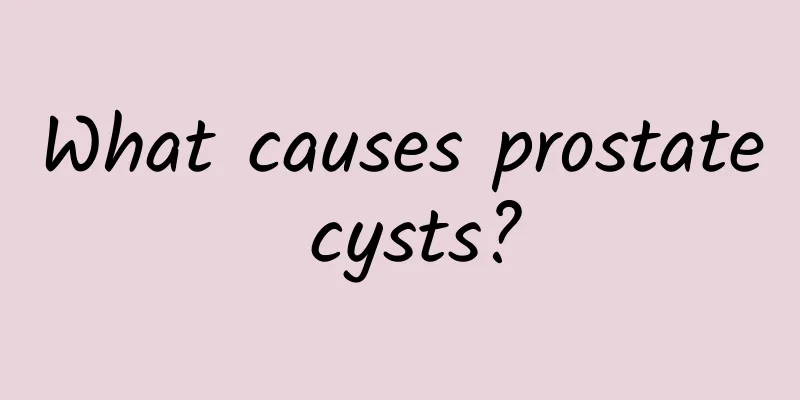What causes prostate cysts?

|
As we all know, the prostate gland controls the excretion of urine in our body. It is an indispensable and important organ in our male body. So if there is a problem like prostate cyst, is it very serious? Prostate cyst, how much do you know about this disease? If you don't know much about it, I think it is necessary to read this article. After all, it is one of the most important organs in the body. Prostatic cysts are cystic changes of the prostate gland due to congenital or acquired reasons. Congenital cysts are incomplete degeneration of the accessory renal ducts, which fuse in the midline and form a deep diverticulum or cyst under the bladder, opening behind the prostatic urethra. Acquired cysts are caused by incomplete or intermittent obstruction of the alveoli due to the tough prostatic stroma, which gradually thickens the alveolar epithelium and eventually leads to retention cysts. They can be located anywhere in the prostate or protrude to the bladder neck, with a diameter of 1 to 2 cm. Prostatic cysts may be complicated by infection and stones. Larger cysts may compress the urethra and cause dysuria. Common symptoms include urgency, frequency, strained urination, thin urine stream, and urine retention. Congenital prostatic cysts are often accompanied by congenital diseases such as hypospadias, cryptorchidism, and renal dysplasia. When the cyst is larger, rectal examination of the prostate can touch the cyst. Urethral angiography can show an arc-shaped pressure mark in the posterior urethra. Ultrasound and CT can clearly determine its location. Smaller cysts without symptoms do not need to be treated. Larger cysts or small cysts with symptoms can be treated surgically. There are reports of cyst puncture and aspiration through the perineum or rectum under B-ultrasound guidance, followed by injection of coagulant, but recurrence is common. Prostatic cysts are cystic changes in the gland due to congenital or acquired reasons, called prostatic cysts. The onset age of congenital prostatic cysts is 2 months to 75 years old. The cysts are often located above the prostate and on the midline behind the bladder. The size can be very large. The onset age of acquired prostatic cysts is 35 to 55 years old. The cysts can be located anywhere in the prostate or protrude to the neck of the bladder, with a diameter of 1 to 2 cm. The cysts contain clear mucus, but can also be dark brown or bloody. The cause of prostatic cysts is generally due to cystic changes in the prostatic gland due to congenital or acquired reasons. (1) True prostatic cyst: The prostate gland is obstructed during embryonic development, causing the prostatic duct to narrow and become blocked. The contents gradually accumulate and form a retention prostatic cyst. (2) Congenital cysts: They are caused by abnormal development of the mesonephric duct and paramesonephric duct, which results in partial expansion of the lumen and formation of cysts. Cysts arising from the paramesonephric duct are often located in the middle of the posterior prostate, while cysts arising from the mesonephric duct are located on both sides. This type of cyst does not actually originate from the prostate and is often adhered to the posterior wall of the bladder. It can often grow to a large size, compressing the bladder neck and causing dysuria; compressing the rectum and causing anal distension and difficulty in defecation. Congenital prostatic cysts are often accompanied by congenital diseases such as hypospadias, cryptorchidism, and renal dysplasia. (3) Acquired cysts: They are caused by the tough prostate stroma, which leads to incomplete or intermittent obstruction of the alveoli, gradually thickening the alveolar epithelium and eventually causing retention cysts. They can be located anywhere in the prostate or protrude to the bladder neck, with a diameter of 1-2 cm. (4) Inflammatory cyst: Chronic prostatic inflammation causes connective tissue hyperplasia, leading to narrowing of the prostatic ducts and retention of secretions to form cysts. (5) Parasitic cysts: caused by parasites such as hydatid cysts, which can cause chronic inflammation in the prostate duct and surrounding areas, or granulation hyperplasia, gradually forming cysts. If you or your family and friends have such problems, you might as well recommend this article to them. Many people do not have a correct understanding of this disease and blindly think that it is very serious. In fact, it is not the case. When facing illness, we should have a serious and scientific attitude and strive for a speedy recovery. |
<<: What to do if you have bacterial infection of glans?
>>: Is male prostatitis contagious?
Recommend
Testicles feel swollen
Testicular swelling and pain in male friends is a...
10 "Military Rules" for Men's Health
1. Have the highest level of HDL About 356,000 me...
What does it mean when the testicles are very small?
Most men are aware of this basic knowledge. If yo...
Diet and health care for male urethral stones
Urethral stones are a relatively serious disease....
Small papules on both sides of the frenulum
Male reproductive problems are usually related to...
What to do if there is a lump on the foreskin
The foreskin is actually the skin on the male pen...
How to diagnose glansitis?
Penile glans inflammation is a common disease amo...
What to do if the testicles become itchy and peeling the more you rub them
The testicles are also one of the most important ...
Is coix seed effective in treating hydrocele of spermatic cord?
Hydrocele is a common disease in men. The cause m...
What can men eat to prolong their sexual intercourse? Here is a tip that will work wonders!
Sexual life is a seasoning for the relationship b...
What are the early symptoms of prostatitis?
It is difficult to pay attention to the early sym...
How to treat small red bumps on the coronal sulcus?
The coronal sulcus is a part of the male reproduc...
Why are the testicles wet and smelly?
Some male friends will find that their testicles ...
What should men do if they have yang deficiency? Self-care methods for yang deficiency
In traditional Chinese medicine, Yang deficiency ...
The benefits and effects of washing your face with vinegar make your face look tender and tender!
Vinegar is an indispensable condiment in life, es...









